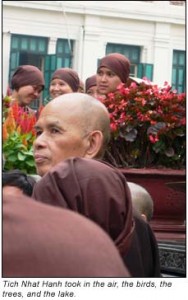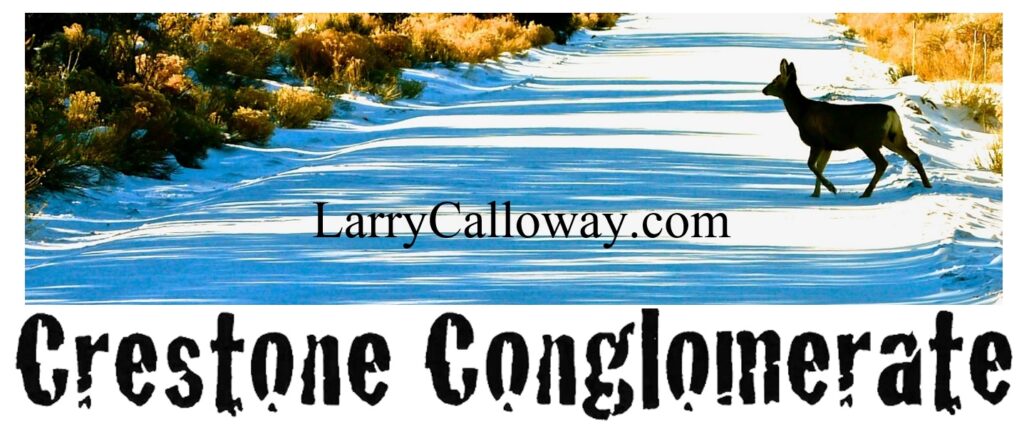Thich Nhat Hanh’s return to Vietnam in May for a retreat followed by a United Nations conference was a triumph for his “engaged Buddhism.” Not only was his global influence evident at the conference, but he and 400 retreatant-delegates (most of us Westerners) were warmly received on a dramatic slow walk in the center of Hanoi.

Triumph perhaps is too military a term for the vindication of an 81-year-old monk who teaches, “Peace is every step,” but his young life was defined by war, as was his ancient nation. Not until 1985 was he free to return after 39 years of exile, first by the anti-communists, then by the communists.
Sponsoring the 2008 UN “Vesak Conference,” as it is called, was a significant move for the Socialist Republic of Vietnam, which has been criticized for religious repression but is encouraging tourism and the recovery of ancient cultural traditions. Vesak is an important Buddhist holiday that the UN in 1999 resolved to recognize yearly. The first four conferences were held in Bangkok, a center for the Theravada Buddhism of Thailand, Laos, Cambodia, Burma and Sri Lanka but not Vietnam, whose Mahayana tradition can be traced to Chinese Chan (Zen).
The conference at Hanoi’s proud new National Convention Center included formal workshops on a variety of issues addressed by Nhat Hanh and his monastic representatives. But because the world continues to suffer from “the scourge of war,” and perhaps because the conference was for the first time in Vietnam, the issues of war, conflict and healing were foremost.
In his opening address, Bikkhu Bohdi, a Pali sutras authority from Chulalongkorn University in Thailand, made the connection between world peace and Buddhism, saying, “No doubt meditation and moral principles contribute to peace, since war begins in the minds of men.” Or, as Nhat Hanh put it in his keynote address, “The roots of war and conflict are in us!”
He proposed “the idea of engagement,” he told us, in his first published article in 1954. (Engaged Buddhism, with its mindfulness training and emphasis on precepts, is a worldly practice, not a philosophy.) It was, as he put it, “a time of great confusion” in Vietnam. (The French colonialists, defeated at Dien Bien Phu, were exiting and the Americans, covert sponsors of the Ngo Dinh Diem regime, were entering.) As war formed in the minds of McNamara, Rusk, Bundy, the joint chiefs, the Kremlin, Mao, and others, the Vietnam Buddhists countered, in so many words: Leave Vietnam alone!
Perhaps because this was Vietnam, Nhat Hanh’s dharma talks in the eight-day retreat dwelled on the American war, as it is known there. The people of the small nation were caught between foreign ideologies. “Everyone was willing to die for ideologies,” he said, but Buddhism teaches freedom from ideology. The fighting was with ideas and weapons from the outside. “How can you fight such a war? Brother against brother?”
On June 11, 1963, some monks boarded a Peugeot sedan at a monastery in Hue and drove to a busy intersection in Saigon, where they stopped and got out with a five-gallon container. One of them, Quang Duc, sat cross-legged, was doused with gasoline and burned to death without moving. The news photos of the self immolation were a global sensation, contributing to the unintended chain of events that led to the assassination of Diem and his brother in early November (three weeks before the assassination of President Kennedy.) The historic Peugeot is now on display in a pavilion at the Hue monastery.
“Some had to burn themselves alive to tell people we don’t want this war,” Nhat Hanh remembered. In the early sixties he went often to the United States, where he would eventually study at Princeton, lecture at Cornell and teach at Columbia. He was a powerful multilingual anti-war speaker. But sometimes there was a problem. At a huge anti-war rally in 1966 a young man suddenly yelled, “Why are you here? You should be in Vietnam fighting the American imperialists!” In other words, Nhat Hanh said, the man wanted him to fight, to kill Americans. He answered, “Well, I thought the root of the war was here—in Washington—and that’s why I have come.”
In Hanoi, I met Paul Davis, who had a similar thought at an anti-war march in New York in the sixties. People started yelling, “Ho Chi Minh, Ho Chi Minh, you’re the one who’s gonna win.” That was never the point.
Paul was no ordinary protestor. He had joined the United States Marines two weeks after his high school graduation in rural Ohio and landed at Da Nang in 1965, when the U.S. under President Johnson began direct combat operations. Davis was wounded in 1966, and while recovering in the U.S. appeared as a Marine on a panel at a college. Someone asked him if the Vietnamese wanted us there. He spun out a long response, and his interlocutor said, “You have not answered the question.” In a Zenlike, koanlike, moment, Paul’s whole mental being suddenly dissolved. He held back tears. Somehow his life had changed forever.
He began attending Thich Nhat Hanh retreats more than 10 years ago after his son died in a car crash. He now counsels Iraqi veterans and their families. In 2003, Paul obtained his Marine casualty report and followed the coordinates to the point where he was wounded. He recognized the distant horizon that he saw as he waited for evacuation. He would write a poem in the words of the buried mine that got him. This was on Marble Mountain, near Da Nang, named for a pure white quarry. In the village below, dozens of shops now sell artful sculptures to tourists.
Early one morning during the retreat, we boarded buses and took a walk along the shore of the central lake, Hoan Kiem, in down town Hanoi. People were already out doing their morning jogging and aerobics. We left the buses and gathered at the tall statue of Ly Thaito, founder of Hanoi. There were the 400 of us in gray robes, plus 30 or so local Vietnamese nuns in brown robes with conical reed hats. We walked along the old section of Hanoi and past the historic water puppet theatre and turned around near the rock pile monument with the Chinese character for heaven and passed the red bow bridge that goes to an island shrine.
Funny thing, I thought. No police. No wise guys making nervous comments. No angry motorcycle drivers urging our slow-walking meditative line to clear an intersection. Just people watching, curious. Then, about half way through the demonstration, I noticed some of them were lining up along our way. And they were standing respectfully with their palms together at their hearts.
Back at the foot of Ly Thaito sat Thich Nhat Hanh, diminutive and smiling. Many of us sat around him, as if waiting for a lesson. Without comment, he took in the air and the morning sun and the trees and the birds and the lake, which was at our backs. He suggested that we all turn around, that the view was much better that way. He smiled. He was home.
